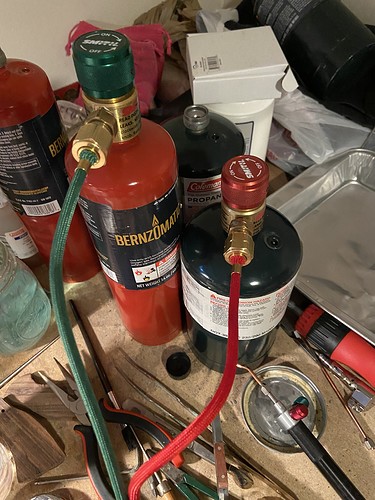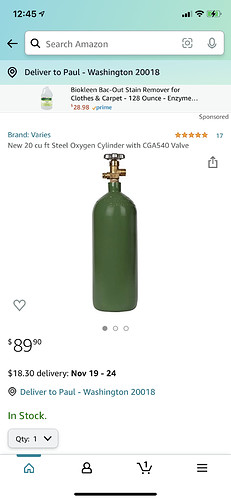I just got a new smith little torch and it is driving me nuts. No matter what I do I can’t get the damn thing to light. The propane will light but as soon as I try to add oxygen it just goes out. If I try to light a larger flame I can see a let’s say empty space appear between the torch tip and the flame. Then it goes out. I tried changing the oxygen bottles and get the same result. Could both bottles be bad? I am using the smaller bottles like you can get from the hardware store. Any ideas will be gladly accepted.
You have oxygen, because you are getting a flame separated from the torch tip, as you describe…this is a symptom of too high oxygen pressure, so there’s enough oxygen at a high enough pressure in the tank. Somehow you are not getting any oxygen at the lower pressure and then getting too much…I would guess that your regulator is bad, but it could have something to do with check valves or flashback arrestors if you have one of those.
Bet thing to do would be to take the rig to a local welding supply and see what they say about it…they are the experts. -royjohn
It’s not really much of a set up. I have the little regulators that screw on.
No matter which tip I use I can get a flame from the propane but as soon as I add oxygen the flame goes out. It’s infuriating. This is a new little smith torch set I got to replace the one that was acting up. I’m starting to think it’s the oxygen.
I switched to map gas and I got the flame like I’m supposed to but as soon as I add the oxygen the flame zips out.
It’s not the oxygen, it’s the pressure regulation (or lack thereof). You need a 2-stage gauge/regulator on the oxygen to bring it down to a pressure that’s compatible with the fuel gas.
Maybe it’s the pressure In The new cans. I’ve had the same set up for a year now and thought there was something g wrong with the last torch. Getting the same result with the new torch. All the tips act the same. Mis there a regulator that can go on the small oxygen cans.
As far as I can see, there’s no regulator there.
You need a device to reduce the pressure from the bottle to the torch. A regulator can probably be bought from where you got the bottle.
The valve on the bottle is supposed to be fully open or fully closed.
Regards Per-Ove
Edit to add:
I can’t see any flashback arrestors either, maybe you should do a full revision of your setup?
It he little knobs on the bottles are pre set regulators for the little torch. Maybe to one for the oxygen has gone bad. Perhaps I should step up to a real regulator.
Just a simple test, not accurate and very subjective.
Hold the tip against some debris, then open the oxygen.
There should be a gentle stream coming out.
Then the same for the gas, it should be more or less equal.
Just my 2cents.
Per-Ove
I had problems with this same set up because the pressure cannot be adjusted. I upgrade to an oxygen tank with a regulator that shows line pressure and tank pressure. Thanks a allows me to adjust the oxygen pressure so the flame does not blow out when I add oxygen. Problem solved. In addition, the standard oxygen tank lasts so much longer.
Could it be that you are opening the knob on the torch too quickly? In the beginning I was popping the flame instantly without realising how quick the knob works. Try to begin with a smaller gas flame and then add a little bit of oxygen, open the gas a little bit more, add oxygen and so on. The smaller the tip the easier the flame pops if not done right.
As a side note, the oxygen cylinder will last you a short while and it’s not worth it. I suggest researching some used oxygen concentrators. You will save a lot of money in the long run with one.
This reply looks like good advice. If it doesn’t work, then you might consider that you have a defective regulator or O2 cylinders full of air. Non-adjustable regulators are just that. They are on or off with a fixed pressure regulation setting. The only adjustment you have is at the torch handle. The many suppliers that we buy from offer a Little Torch outfit with these regulators on both the gas an O2 cylinders. I have to guess that they work. You will use O2 at about 4X the rate that you use propane. I would agree that you should look at an O2 concentrator. Good luck…Rob
I may just do that. Is it hard to replace or get the larger canister filled?
Been looking around and I think I might go with
And there are regulators from $80-$250. Any recommendations would be appreciated.
Just a heads up here… It will cost you almost as much to fill a 20 cu ft tank as it will to fill a 40 cu ft tank. Actually, it costs almost as much to fill a 40 cu ft tank as it does to fill an 80 cu ft tank.
Last time I filled up my 40 cost $17.84 and my 80 cost $20.41.
A 40 cu ft tank is still a quite manageable size but an 80 cu ft tank is pretty hefty.
– alonzo
hi,
regarding buying a tank…before doing that, call your local gas place…(ie: airgas, praxair, etc)
in my personal experience, i went in the first time, and they charged me a fee for the (used) tank, and a fee for the fill
then, each subsequent visit, they swap out the empty tank for a filled one, and charged me the fee for a fill.
ie: they would not fill my personal tank each time…they would swap it out for a filled used tank, and my tank would just go into their rotation system….in this instance, they dont charge you the tank charge because you are giving them your tank…
so, call first…and, their tank charge may be less than the peice of a new tank
julie
hi,
also, read up on how to transport cannisters in the car…i think they need to be secured in an upright position
do your research…safety first
julie
As Julie suggested, before purchasing call you local air gas supplier and find out how they charge for entering the system. They normally require that you give them your lovely pristine new empty tank or that you pay the price that they would charge for buying a new one from them. From then on you only pay the refill charge.
They don’t actually refill at the retail location. There is a central location where they extract oxygen and other gasses from the air. Air is a mixture of gases, consisting primarily of nitrogen (78 %), oxygen (21 %) and the inert gas argon (0.9 %). The remaining 0.1 % is made up mostly of carbon dioxide and the inert gases neon, helium, krypton and xenon. (More than you wanted to know? lol) This central location has very expensive equipment, and it takes time to refill. You won’t find a local supplier that will refill your tank.
I bring this up because there are times when a newb goes to get gas and they feel cheated when they are given an old banged up and rusty cylinder.
Dozuki, I just noticed by your zip code on the Amazon page that you live very near a fantastic jewelry school. They use all Smith Little Torches and the techniques that are taught by the goldsmith owner are sophisticated and lead you to being able to create amazing jewelry. Check out their website: jewelryclassdc.com. Vera
i think they need to be secured in an upright position
Need to be and are can be different. I once saw one of the really tall O2 tanks being loaded through the raised hatchback into a Chevy Vega. It looked like the loading of a torpedo into a mini submarine.
At least where I am, how you transport is your business.
But yes, tanks should be well secured, standing up, preferably in the open bed of a pickup truck.
Neil A
It is a great place to take classes. I’ve taken a few there.

